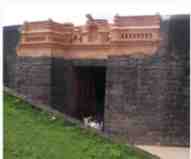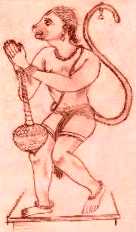Palaghat
The Kerala State is protected naturally by the Western Ghats on one side and on the other by the sea. To get connected to the rest of India, there are two strategic passes through which the Western Ghats could be crossed. One is near Kottayam and the other is near Palakkad. Thus Palaghat had assumed importance and served as a link for Kerala, Mysore State, and Madras State.
Hyder Ali in Palaghat
 Hyder Ali, under whose rule the area of Palaghat was falling, had his interest in
controlling the areas of Mysore, Malabar, South Canara, and Coimbatore. Therefore
Palaghat had assumed importance, and he had positioned some of his army in this
strategically important place. Considering the oppression he was facing from the
British forces, he had to reinforce his army with more men and ammunition. Hence he
decided to build a fort in this strategically located Palaghat and constructed one
in the year 1766. Once the fort was built, he improved upon the fort in later years
with the help of his French advisors.
Hyder Ali, under whose rule the area of Palaghat was falling, had his interest in
controlling the areas of Mysore, Malabar, South Canara, and Coimbatore. Therefore
Palaghat had assumed importance, and he had positioned some of his army in this
strategically important place. Considering the oppression he was facing from the
British forces, he had to reinforce his army with more men and ammunition. Hence he
decided to build a fort in this strategically located Palaghat and constructed one
in the year 1766. Once the fort was built, he improved upon the fort in later years
with the help of his French advisors.
The British captured the Palaghat fort from Hyder Ali in 1784 after eleven days of siege. But soon the British lost control of the fort, and Hyder Ali recaptured it again. But once again in September 1790, the British took control of the fort. The British had improved upon the fort when under their control.
The Fort of Palaghat
The mammoth fort is rhombic in shape with a huge moat of about thirty feet wide running all around the fort. Built with granite rocks, to a good height. The outer wall was nearly ten feet thick, so big that a column of army could move on the top of the outer wall itself. For the entire fort, there is only one gateway in the East. During old times, one could enter the fort only through the split bridge operable from inside the fort. Two big logs used to be brought together for passing over the moat.
While there is no carving of any art figures in and around the fort, near the eastern entrance of the fort there is a figure of Anjaneya carved on the inner side of the wall.
Today the fort houses a sub jail and a taluk office. Archaeologically, there is nothing special except that there is a stepped well and a small-pillared mandapa where A.S.I. had put up a small gallery now. The pillars of the mandapa have no special carving as that of any Godhead or symbols, etc.
Temple for Anjaneya in fort
Today this fort is visited by thousands of locals every day for a different reason. While there is no carving of any art figures in and around the fort, near the eastern entrance of the fort there is a figure of Anjaneya carved on the inner side of the wall. It is worth mentioning here that some of the forts built during the time of Hyder Ali/Tupu Sultan have Anjaneya figures in 'ardha shilpa' form or in shilpa form in or around the fort. The Lord was worshipped by the warriors, and the Lord is known as Kote Anjaneya (kote in South Indian language means fort). Presently a small temporary shed had been erected in front of the carving, without affecting the archaeological beauty of the fort. It is said that the carving dates back to Tupu Sultan. The warriors of his army, who were basically from Mysore, had unshakeable faith in the prowess of Lord Anjaneya, and it is felt that they must have had the carving made at the entrance of the fort as the God of Guards.
Lord Anjaneya of Palaghat Fort
 The murthi of Lord Anjaneya is south-facing, while the Lord Himself is facing west.
The ardha-shilpa carving of the Lord is about seventeen inches in height. He
is seen in the standing posture with the 'ghatha' (mace) held in the
'Anjali Hasta' (folded hands). The lord's 'laukuulam' (tail) is raised
and curved with a small bell at the end of the tail. He has his right leg forward,
and the left is seen just raised and ready to move. The Lord had been an inspiration
for many warriors who had been living here during those days. He had been a
protector of the warriors who had plunged their faith in Him.
The murthi of Lord Anjaneya is south-facing, while the Lord Himself is facing west.
The ardha-shilpa carving of the Lord is about seventeen inches in height. He
is seen in the standing posture with the 'ghatha' (mace) held in the
'Anjali Hasta' (folded hands). The lord's 'laukuulam' (tail) is raised
and curved with a small bell at the end of the tail. He has his right leg forward,
and the left is seen just raised and ready to move. The Lord had been an inspiration
for many warriors who had been living here during those days. He had been a
protector of the warriors who had plunged their faith in Him.
Bhaktas of the Lord
It is seen to be believed that thousands of locals offer ghee for the lamp on Saturdays and Tuesdays from early morning. Today He continues to inspire many of the Bhaktas who visit Him for their missions' success. The Lord Anjaneya of Palaghat Fort continues to be a protector of the poor and faithful. Next time when you visit Palakkad, visit this temple and bring back inspiration for your mission's success.
Location of the temple: "Sri Kote Anajaneya Swami Temple, Palaghat Fort"
Experience
The Lord Anjaneya of Palaghat Fort continues to be a protector of the poor and faithful. Next time when you visit Palakkad, visit this temple and bring back inspiration for your mission's success.
SRI HANUMAN THINKS DIFFERENTLY, THINKS FAST
THINKS AHEAD AND ACTS FOR SURE
Ed [23.12.03]
Updates: [Jan 2025]
